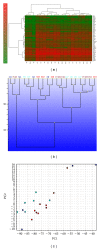Gene expression profiling of human oocytes developed and matured in vivo or in vitro
- PMID: 23509795
- PMCID: PMC3590615
- DOI: 10.1155/2013/879489
Gene expression profiling of human oocytes developed and matured in vivo or in vitro
Abstract
The quality of the human oocyte determines the success of fertilization and affects the consequent embryo development, pregnancy and birth; it therefore serves as a basis for human reproduction and fertility. The possibility to evaluate oocyte quality in the in vitro fertilization programme is very limited. The only criterion which is commonly used to evaluate oocyte quality is its morphology. There is a mass of oocytes in the in vitro fertilization programme which are not fertilized in spite of normal morphology. In the past, several attempts focused on oocyte gene expression profiling by different approaches. The results elucidated groups of genes related to the human oocyte. It was confirmed that some factors, such as oocyte in vitro maturation, are detectable at the molecular level of human oocytes and their polar bodies in terms of gene expression profile. Furthermore, the first genetic evaluations of oocyte-like cells developed in vitro from human stem cells of different origin were performed showing that these cells express some genes related to oocytes. All these findings provide some new knowledge and clearer insights into oocyte quality and oogenesis that might be introduced into clinical practice in the future.
Figures


References
-
- West FD, Machacek DW, Boyd NL, Pandiyan K, Robbins KR, Stice SL. Enrichment and differentiation of human germ-like cells mediated by feeder cells and basic fibroblast growth factor signaling. Stem Cells. 2008;26(11):2768–2776. - PubMed
-
- West FD, Roche-Rios MI, Abraham S, et al. KIT ligand and bone morphogenetic protein signaling enhances human embryonic stem cell to germ-like cell differentiation. Human Reproduction. 2010;25(1):168–178. - PubMed
-
- Richards M, Fong CY, Bongso A. Comparative evaluation of different in vitro systems that stimulate germ cell differentiation in human embryonic stem cells. Fertility and Sterility. 2010;93(3):986–994. - PubMed
Publication types
MeSH terms
LinkOut - more resources
Full Text Sources
Other Literature Sources
Miscellaneous

